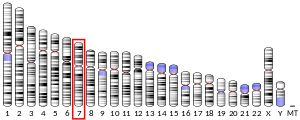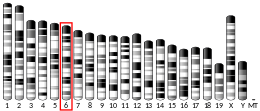Homeobox protein Hox-A3 is a protein that in humans is encoded by the HOXA3 gene.[5][6][7]
Function
editIn vertebrates, the genes encoding the class of transcription factors called homeobox genes are found in clusters named A, B, C, and D on four separate chromosomes. Expression of these proteins is spatially and temporally regulated during embryonic development. This gene is part of the A cluster on chromosome 7 and encodes a DNA-binding transcription factor which may regulate gene expression, morphogenesis, and differentiation. Three transcript variants encoding two different isoforms have been found for this gene.[7]
During normal fetal development, HoxA3 is expressed in mesenchymal neural crest cells and endodermal cells found in the third pharyngeal pouch.[8] Expression of HoxA3 in these cells affects the proper formation of the thymus, thyroid, and parathyroid organs.[9][10] While the gene does not seem to affect the proliferation or migration of the pharyngeal neural crest cells, it does appear to trigger cellular differentiation events required to form these organs.[9] Knockout of HoxA3 leads to failure in forming the thymus (athymia) and parathyroid gland (aparthyroidism).[10] Mutant HoxA3 also causes a reduction in thyroid size. While the follicular and parafollicular cells still differentiate, their numbers are reduced and they are not evenly distributed throughout the gland.[9] Mutant HoxA3 models show similar phenotypes as those seen in DiGeorge's syndrome, and it is possible that the two are linked.[9]
Regulation
editSee also
editReferences
edit- ^ a b c GRCh38: Ensembl release 89: ENSG00000105997 – Ensembl, May 2017
- ^ a b c GRCm38: Ensembl release 89: ENSMUSG00000079560 – Ensembl, May 2017
- ^ "Human PubMed Reference:". National Center for Biotechnology Information, U.S. National Library of Medicine.
- ^ "Mouse PubMed Reference:". National Center for Biotechnology Information, U.S. National Library of Medicine.
- ^ McAlpine PJ, Shows TB (July 1990). "Nomenclature for human homeobox genes". Genomics. 7 (3): 460. doi:10.1016/0888-7543(90)90186-X. PMID 1973146.
- ^ Scott MP (November 1992). "Vertebrate homeobox gene nomenclature". Cell. 71 (4): 551–3. doi:10.1016/0092-8674(92)90588-4. PMID 1358459. S2CID 13370372.
- ^ a b "Entrez Gene: HOXA3 homeobox A3".
- ^ Hunt P, Gulisano M, Cook M, Sham MH, Faiella A, Wilkinson D, et al. (October 1991). "A distinct Hox code for the branchial region of the vertebrate head". Nature. 353 (6347): 861–4. Bibcode:1991Natur.353..861H. doi:10.1038/353861a0. PMID 1682814. S2CID 4312466.
- ^ a b c d Manley NR, Capecchi MR (July 1995). "The role of Hoxa-3 in mouse thymus and thyroid development". Development. 121 (7): 1989–2003. doi:10.1242/dev.121.7.1989. PMID 7635047.
- ^ a b Chojnowski JL, Masuda K, Trau HA, Thomas K, Capecchi M, Manley NR (October 2014). "Multiple roles for HOXA3 in regulating thymus and parathyroid differentiation and morphogenesis in mouse". Development. 141 (19): 3697–708. doi:10.1242/dev.110833. PMC 4197593. PMID 25249461.
- ^ Han L, Witmer PD, Casey E, Valle D, Sukumar S (August 2007). "DNA methylation regulates MicroRNA expression". Cancer Biology & Therapy. 6 (8): 1284–8. doi:10.4161/cbt.6.8.4486. PMID 17660710.
Further reading
edit- Apiou F, Flagiello D, Cillo C, Malfoy B, Poupon MF, Dutrillaux B (1996). "Fine mapping of human HOX gene clusters". Cytogenetics and Cell Genetics. 73 (1–2): 114–5. doi:10.1159/000134320. PMID 8646877.
- Bonaldo MF, Lennon G, Soares MB (September 1996). "Normalization and subtraction: two approaches to facilitate gene discovery". Genome Research. 6 (9): 791–806. doi:10.1101/gr.6.9.791. PMID 8889548.
- Manley NR, Capecchi MR (March 1998). "Hox group 3 paralogs regulate the development and migration of the thymus, thyroid, and parathyroid glands". Developmental Biology. 195 (1): 1–15. doi:10.1006/dbio.1997.8827. PMID 9520319.
- Sanger Centre, Washington University Genome Sequencing Center (November 1998). "Toward a complete human genome sequence". Genome Research. 8 (11): 1097–108. doi:10.1101/gr.8.11.1097. PMID 9847074.
- Mulder GB, Manley N, Maggio-Price L (December 1998). "Retinoic acid-induced thymic abnormalities in the mouse are associated with altered pharyngeal morphology, thymocyte maturation defects, and altered expression of Hoxa3 and Pax1". Teratology. 58 (6): 263–75. doi:10.1002/(SICI)1096-9926(199812)58:6<263::AID-TERA8>3.0.CO;2-A. PMID 9894676.
- Manzanares M, Nardelli J, Gilardi-Hebenstreit P, Marshall H, Giudicelli F, Martínez-Pastor MT, et al. (February 2002). "Krox20 and kreisler co-operate in the transcriptional control of segmental expression of Hoxb3 in the developing hindbrain". The EMBO Journal. 21 (3): 365–76. doi:10.1093/emboj/21.3.365. PMC 125344. PMID 11823429.
- Kosaki K, Kosaki R, Suzuki T, Yoshihashi H, Takahashi T, Sasaki K, et al. (February 2002). "Complete mutation analysis panel of the 39 human HOX genes". Teratology. 65 (2): 50–62. doi:10.1002/tera.10009. PMID 11857506.
- Kim J, Bhinge AA, Morgan XC, Iyer VR (January 2005). "Mapping DNA-protein interactions in large genomes by sequence tag analysis of genomic enrichment". Nature Methods. 2 (1): 47–53. doi:10.1038/nmeth726. PMID 15782160. S2CID 6135437.
- Wissmüller S, Kosian T, Wolf M, Finzsch M, Wegner M (2006). "The high-mobility-group domain of Sox proteins interacts with DNA-binding domains of many transcription factors". Nucleic Acids Research. 34 (6): 1735–44. doi:10.1093/nar/gkl105. PMC 1421504. PMID 16582099.
External links
edit- HOXA3+protein,+human at the U.S. National Library of Medicine Medical Subject Headings (MeSH)
This article incorporates text from the United States National Library of Medicine, which is in the public domain.




